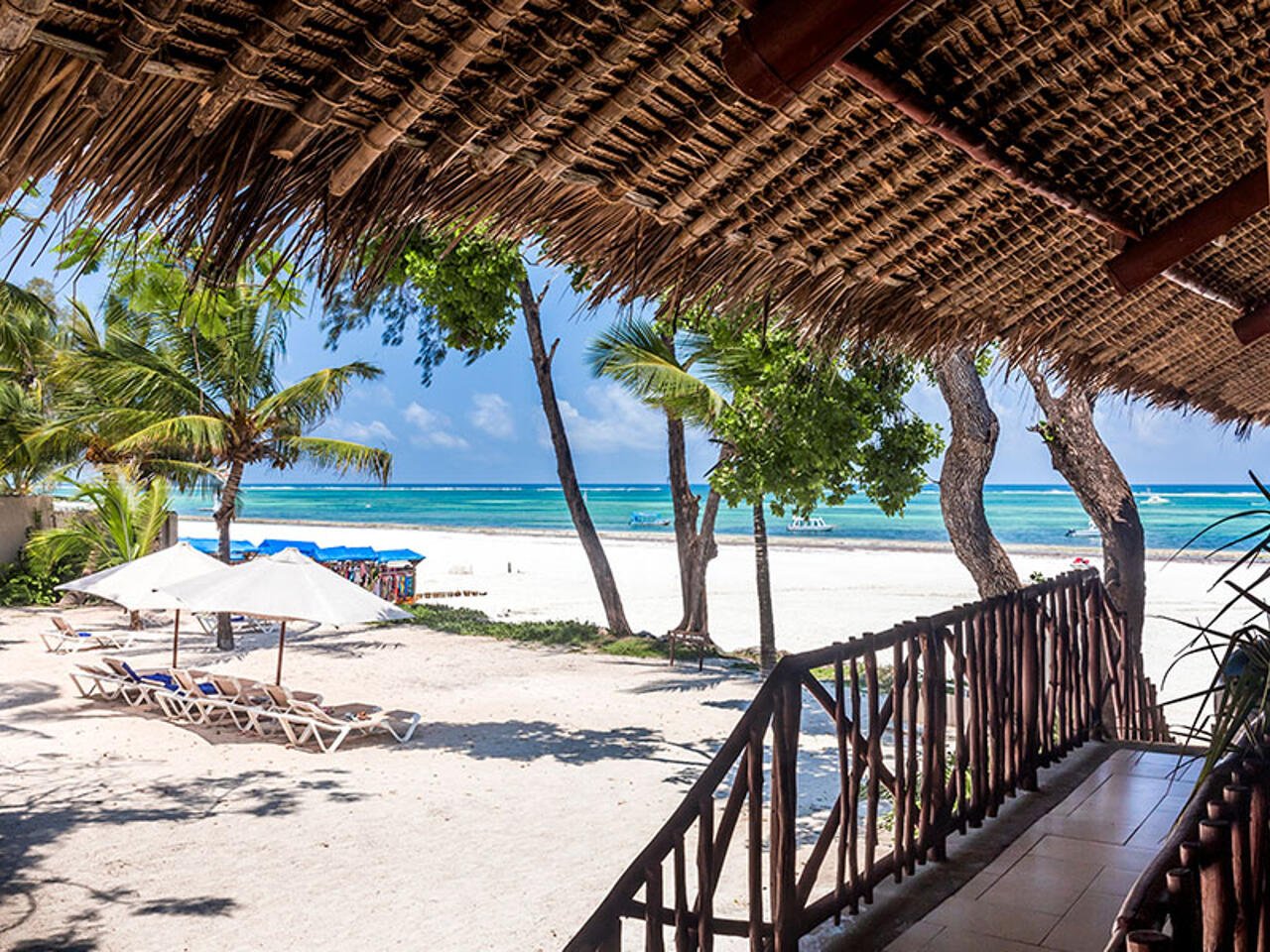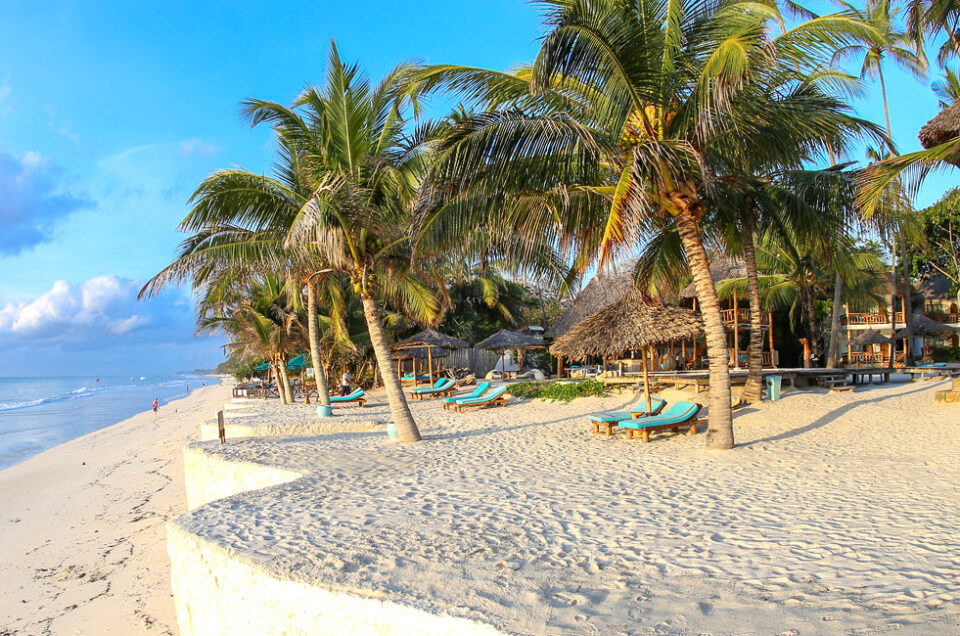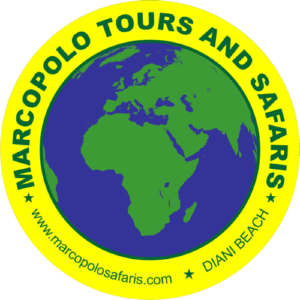Introduction to Diani Beach
Stretching along Kenya’s southern coastline, Diani Beach is one of Africa’s most breathtaking seaside destinations. Known for its powdery white sands, turquoise waters, and swaying palm trees, it has consistently ranked among the world’s best beaches. Diani isn’t just about relaxation—it’s a hub of adventure, culture, and luxury, offering a perfect balance for travelers of all kinds. Whether you’re seeking a romantic honeymoon, a family vacation, or an adrenaline-filled holiday, Diani Beach promises an unforgettable experience.
Where is Diani Beach Located?
Diani Beach lies about 30 kilometers south of Mombasa in Kwale County. It runs for approximately 25 kilometers along the Indian Ocean, bordered by lush forests and vibrant coral reefs. Its proximity to Mombasa and direct connections via Ukunda Airstrip make it easily accessible, yet it maintains a sense of seclusion and exclusivity.
Why Diani Beach is World-Renowned
Diani Beach has gained global recognition thanks to its unique blend of natural beauty, adventure activities, and luxury hospitality. It has been voted Africa’s leading beach destination multiple times by the World Travel Awards. What makes Diani stand out is the fact that it isn’t overly commercialized—visitors can still find quiet stretches of beach where nature dominates. At the same time, it has modern resorts, lively nightlife, and access to world-class diving and safari destinations, making it a complete holiday package.
History and Cultural Significance of Diani
Behind the pristine sands lies a deep cultural and historical story that connects Diani to the larger Swahili coast.
Early Coastal Settlements
Diani, like much of Kenya’s coast, has been inhabited for centuries. Archaeological findings suggest the presence of ancient trade routes linking East Africa to Arabia, Persia, and India. Coastal communities thrived on fishing, farming, and trade, exchanging ivory, spices, and gold with merchants who arrived by dhow.
Swahili and Arab Influence
The Swahili culture that developed here is a unique blend of African, Arab, and Persian traditions. Islam became the dominant religion, reflected in the mosques and Islamic schools found in the region. Today, Swahili language, cuisine, and architecture continue to shape Diani’s identity. Festivals, traditional dances, and dhow building are all part of the living heritage that enriches a visit to this paradise.
Geography and Landscape of Diani Beach
Diani Beach isn’t just about sand and sea—it’s a place where diverse landscapes meet.
The 25-Kilometer White Sandy Shoreline
The beach itself stretches for about 25 kilometers, with powdery, soft sand that doesn’t overheat even in the midday sun. The shallow waters near the shore make it family-friendly, while the long uninterrupted stretch is perfect for walks, jogs, or horseback rides along the ocean.
Coral Reefs and Marine Ecosystems
Just offshore lies an extensive coral reef system that protects the beach from strong waves and creates perfect conditions for snorkeling and diving. These reefs are teeming with marine life, from colorful fish to sea turtles, and they are part of Kenya’s protected marine areas.
Surrounding Forests and Kaya Sacred Groves
Behind the beach, Diani is bordered by coastal forests that house rare species like the endangered colobus monkey. Scattered within these forests are Kaya sacred groves, ancient spiritual sites of the Mijikenda people. Recognized as UNESCO World Heritage Sites, these groves hold cultural and spiritual significance, making Diani not just a beach destination but also a cultural journey.
Marine Life at Diani Beach
Diani’s waters are a playground for marine life, attracting snorkelers, divers, and wildlife enthusiasts from around the globe.
Dolphins, Whales, and Sea Turtles
The Indian Ocean waters near Diani are home to playful bottlenose dolphins, which can often be seen during boat excursions. Between August and October, humpback whales migrate through the area, offering spectacular sightings. Several species of sea turtles, including the green and hawksbill turtles, also nest along Diani’s beaches, making it an important conservation zone.
Coral Reefs and Tropical Fish
The coral reef system near Diani is alive with tropical fish in dazzling colors—parrotfish, angelfish, butterflyfish, and many more. Diving or snorkeling trips reveal a vibrant underwater world that rivals some of the best dive spots in the world.
Birdlife Along the Coast
Diani is also home to diverse bird species. From sea eagles soaring overhead to sandpipers and herons wading along the shore, birdwatchers find plenty to marvel at in this coastal paradise.
Things to Do at Diani Beach
Diani is more than just lounging on the sand—it’s a hub of adventure and activities for all kinds of travelers.
Snorkeling and Scuba Diving
The coral reefs provide some of Kenya’s best diving opportunities. Professional dive centers in Diani offer certification courses, guided dives, and snorkeling trips to spots teeming with marine life. Whether you’re a beginner or an experienced diver, the clear waters and abundant marine biodiversity make every dive unforgettable.
Kitesurfing, Windsurfing, and Water Sports
With its steady winds and warm waters, Diani has become East Africa’s kitesurfing capital. Surf schools along the beach rent equipment and offer lessons. Visitors can also try windsurfing, paddleboarding, jet skiing, and banana boat rides.
Skydiving and Deep-Sea Fishing
For thrill-seekers, skydiving over Diani Beach is an experience like no other. Imagine jumping out of a plane and freefalling with the turquoise ocean and white sands beneath you. Deep-sea fishing is another adventure, with chances to catch marlin, tuna, and sailfish.

Day Trips and Excursions from Diani
Diani Beach is perfectly located for travelers who want to mix sunbathing with adventure. Beyond the shoreline, a range of excursions lets you experience Kenya’s wildlife, culture, and hidden islands.
Shimba Hills National Reserve
Just 45 minutes inland from Diani, Shimba Hills is a lush, green escape from the coast. Known for its rolling hills, waterfalls, and dense forests, the reserve is home to elephants, leopards, giraffes, and the rare sable antelope. The cool climate offers a refreshing contrast to the beach heat. Visitors can hike to Sheldrick Falls, enjoy game drives, and take guided nature walks. For those who want both safari and sea in one trip, Shimba Hills is a must-do day excursion.
Funzi Island and Sandbank Picnics
A short drive and boat ride south of Diani takes you to Funzi Island, a hidden gem with pristine mangroves and endless sandbanks. Dhow safaris along the Ramisi River reveal crocodiles, kingfishers, and calm tidal creeks. The highlight is a sandbank picnic—where you dine on fresh seafood with the ocean lapping at your feet. Funzi also plays a key role in turtle conservation, giving visitors the chance to support eco-tourism.
Wasini Island and Kisite-Mpunguti Marine Park
For snorkelers and divers, Wasini Island is paradise. Just an hour’s journey from Diani, it sits beside Kisite-Mpunguti Marine Park, one of Kenya’s most famous snorkeling spots. Here, coral gardens teem with tropical fish, dolphins glide past boats, and humpback whales are spotted seasonally. On Wasini Island, visitors can also explore Swahili villages, mangrove boardwalks, and enjoy traditional coastal meals of coconut rice and seafood.
Diani’s Culture and Local Experiences
While the beach is stunning, Diani’s soul lies in its people and culture.
Swahili Traditions and Coastal Communities
Diani is part of the Swahili Coast, where African, Arab, and Persian influences blend into a unique culture. The local communities speak Swahili, a language that reflects centuries of trade and cultural exchange. Traditions such as dhow building, Swahili poetry (utendi), and Islamic festivals like Eid are still alive here. Visitors often find the warm hospitality of the locals to be just as memorable as the scenery.
Local Cuisine and Seafood Delicacies
Food in Diani is a delicious reflection of its coastal heritage. Fresh seafood—lobster, prawns, crab, snapper, and octopus—dominates menus, often cooked in coconut milk and spices. Street food stalls sell viazi karai (spiced potatoes), samosas, and mishkaki (grilled meat skewers). A visit isn’t complete without tasting coconut rice and washing it down with madafu (fresh coconut water). Many resorts also offer fusion dining, blending international flavors with Swahili traditions.
Nightlife and Entertainment
Diani isn’t just about quiet sunsets—it has a vibrant nightlife scene. Beachfront clubs, reggae bars, and open-air lounges come alive after dark. Popular spots like Forty Thieves Beach Bar attract both tourists and locals, offering music, cocktails, and dancing under the stars. For those who prefer a quieter evening, candlelit beach dinners or local cultural shows offer a more relaxed form of entertainment.
Accommodation Options at Diani Beach
From ultra-luxury resorts to budget hostels, Diani caters to every type of traveler.
Luxury Resorts and Villas
Diani is home to some of East Africa’s most exclusive beachfront resorts. Places like Swahili Beach Resort and The Sands at Nomad offer infinity pools, private villas, and spas overlooking the ocean. Luxury travelers can expect personalized services such as private butlers, gourmet dining, and beachfront yoga sessions.
Mid-Range Hotels and Lodges
For travelers seeking comfort without breaking the bank, Diani has excellent mid-range options. Boutique lodges and hotels offer cozy rooms, swimming pools, and beachfront access. Many of these are family-friendly, offering kids’ clubs and activities while maintaining an intimate atmosphere.
Budget Stays, Guesthouses, and Backpacker Hostels
Budget travelers aren’t left out—guesthouses and backpacker hostels provide affordable stays with a community vibe. Hostels often organize group activities such as bonfire nights, beach clean-ups, and snorkeling trips, making them perfect for solo travelers. Staying at a local guesthouse also supports small businesses and provides a closer connection to the community.
How to Get to Diani Beach
Getting to Diani is easy, with multiple transport options from Kenya’s major cities.
From Mombasa by Road and Air
Most travelers arrive through Mombasa, Kenya’s coastal hub. From there, Diani is about 30 kilometers south. The Likoni Ferry connects Mombasa Island to the south coast, followed by a scenic drive to Diani. Alternatively, local flights from Moi International Airport (Mombasa) to Ukunda Airstrip take just 15 minutes.
From Nairobi and Other Cities
From Nairobi, travelers can take a one-hour flight directly to Ukunda. Road trips from Nairobi are possible but long (about 8–10 hours). The SGR train from Nairobi to Mombasa is another popular option, offering comfort and affordability, followed by a short road or air transfer to Diani.
Local Transport Around Diani
Once in Diani, transport is easy. Tuk-tuks, motorbikes (bodabodas), and taxis are widely available. For independent travelers, car rentals are also an option, though many prefer exploring on foot or bicycle due to the beach town’s laid-back pace.
Best Time to Visit Diani Beach
Like all tropical destinations, timing your trip makes a big difference in your experience.
Weather and Climate Conditions
Diani enjoys a warm tropical climate year-round, with temperatures between 25°C and 32°C. The best weather falls in the dry seasons: December to March and July to September. These months are perfect for diving, snorkeling, and outdoor activities. The rainy seasons (April–June and October–November) bring lush greenery but may limit beach outings due to heavy showers.
Peak and Off-Peak Tourist Seasons
December is the busiest time, as holidaymakers flock to the coast. During peak season, expect lively beaches, higher hotel rates, and a festive atmosphere. If you prefer quieter travel, the off-peak months of May and June offer lower prices and fewer crowds, though with occasional rainfall.
Conservation and Sustainability in Diani
Diani’s beauty and biodiversity are among its greatest treasures, but they also face threats from overdevelopment, pollution, and climate change. Thankfully, conservation and sustainable tourism are becoming central to preserving this paradise for future generations.
Protecting Coral Reefs and Marine Life
The coral reefs off Diani’s coast are vital ecosystems, home to countless marine species. Organizations and dive centers in the area work to monitor reef health, run awareness campaigns, and promote eco-friendly snorkeling and diving practices. Fishermen are also being encouraged to adopt sustainable methods, ensuring that marine life like sea turtles, dolphins, and tropical fish remain abundant.
Visitors play a role too—by avoiding coral damage, refusing single-use plastics, and choosing eco-certified operators, tourists can help protect the delicate marine environment.
Eco-Lodges and Responsible Tourism
Eco-lodges have sprung up around Diani, designed to minimize environmental impact while offering luxury experiences. These accommodations often use solar power, recycle water, and serve locally sourced food. Some even support turtle hatcheries, mangrove replanting, and beach clean-up initiatives.
Travelers are encouraged to support these sustainable businesses and participate in eco-tourism activities such as mangrove tours, cultural exchanges, and conservation volunteering. This way, their stay contributes positively to both the community and the environment.
Travel Tips for Visiting Diani Beach
To get the most out of a Diani vacation, preparation and responsible travel go a long way.
What to Pack for a Beach Vacation
Light clothing – breathable fabrics like cotton and linen are best.
Swimwear and water shoes – essential for snorkeling and wading through coral areas.
Sunscreen, sunglasses, and a wide-brimmed hat – the sun here is strong and constant.
Insect repellent – especially useful in the evenings.
Reusable water bottle – to stay hydrated while cutting down on plastic waste.
Snorkeling gear – though widely available for rent, having your own can be convenient.
Camera or drone – to capture Diani’s stunning beaches, sunsets, and marine life.
Safety and Responsible Travel
Swim only in designated safe areas—currents can be strong offshore.
Respect local culture—dress modestly when outside the beach, especially in villages.
Avoid littering—participate in or support beach clean-up programs.
Use trusted taxi services or hotel transfers for safety.
Book tours through certified operators to ensure quality and community support.
Diani Beach vs. Other Coastal Destinations
With several breathtaking beaches across East Africa, many travelers compare Diani with others before choosing where to go.
Comparison with Mombasa Beaches
Mombasa’s Nyali and Bamburi beaches are lively, bustling with activity, and closer to the city. However, they lack the seclusion and pristine beauty of Diani. Diani is quieter, cleaner, and more exclusive, making it better for travelers who want peace alongside luxury.
Comparison with Lamu and Zanzibar
Lamu offers history and culture, with its narrow streets and Swahili architecture, but its beaches are smaller compared to Diani’s vast shoreline.
Zanzibar is world-famous, with spice tours, Stone Town, and lively beaches, but it is more commercialized.
Diani Beach strikes a balance—secluded yet accessible, modern yet authentic, luxurious yet eco-friendly.
For those who want both a serene beach holiday and easy access to safaris and cultural trips, Diani often emerges as the top choice.
Economic Importance of Diani Beach
Tourism at Diani isn’t just about leisure—it plays a crucial role in supporting Kenya’s economy and local livelihoods.
Tourism and Local Employment
Diani’s hotels, resorts, restaurants, and tour companies employ thousands of people, from chefs and guides to artisans and conservationists. Tourism revenue also supports schools, healthcare, and infrastructure in Kwale County, directly benefiting local communities.
Fishing and Business Opportunities
Fishing remains a traditional livelihood, with fresh catches sold to hotels and local markets. Additionally, small businesses like tuk-tuk operators, curio shops, and craft markets thrive thanks to the steady flow of tourists. Visitors who choose to buy handmade souvenirs or dine in local eateries contribute directly to the local economy.
Challenges Facing Diani Beach
As Diani grows in popularity, it faces challenges that could threaten its natural charm.
Climate Change and Beach Erosion
Rising sea levels and stronger storms are eating away at Diani’s shoreline. Seasonal flooding and beach erosion threaten not just tourism but also local communities. Marine ecosystems, particularly coral reefs, are also vulnerable to warming oceans.
Overdevelopment and Conservation Concerns
The growing demand for hotels and resorts has led to fears of overdevelopment. While tourism brings jobs, uncontrolled growth risks straining water resources, damaging ecosystems, and crowding the once-secluded beach. Striking a balance between development and conservation is essential for Diani’s sustainable future.
The Future of Diani Beach
Despite the challenges, the future looks promising for Diani, especially as eco-tourism and sustainable travel gain momentum.
Growing Popularity in Global Tourism
Diani is increasingly featured in international travel magazines, blogs, and awards. Its reputation as one of Africa’s best beaches ensures a steady flow of tourists. With improved infrastructure—like the SGR train and expansion of Ukunda Airstrip—accessibility will only get better.
Balancing Development with Sustainability
The future of Diani lies in maintaining its natural beauty while embracing responsible development. Investments in eco-lodges, conservation projects, and community tourism are already shaping a more sustainable tourism model. If this balance is preserved, Diani will remain a tropical paradise for generations to come.
Conclusion
Diani Beach is more than just a holiday spot—it’s a slice of paradise where turquoise waters meet white sands, where adventure meets relaxation, and where culture blends seamlessly with modern luxury. Whether you’re diving into coral reefs, skydiving over the coastline, dining on fresh seafood, or exploring nearby national parks, Diani offers something for everyone. It is a destination that doesn’t just provide memories—it creates a longing to return.
FAQs
1. How far is Diani from Mombasa?
Diani is about 30 kilometers south of Mombasa, reachable by ferry, road, or local flights to Ukunda.
2. What activities can I do at Diani Beach?
Popular activities include snorkeling, scuba diving, kitesurfing, dhow safaris, skydiving, and day trips to Shimba Hills or Wasini Island.
3. Is Diani Beach safe for tourists?
Yes, Diani is considered safe for tourists, though general travel precautions like avoiding isolated areas at night should be observed.
4. What is the best time to visit Diani Beach?
The dry seasons—December to March and July to September—offer the best beach weather and ocean conditions.
5. Are there budget options for staying in Diani?
Yes, alongside luxury resorts, Diani has guesthouses, backpacker hostels, and mid-range lodges for budget travelers.







